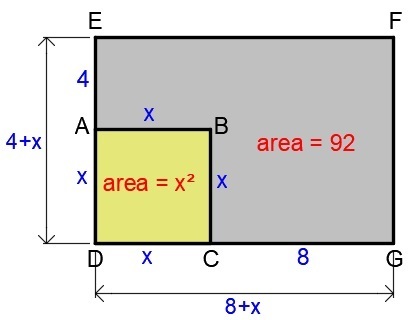The Case Of The Missing Square
Rectangle D E F G has square A B C D removed leaving an area of 9 2 m 2 . Side A E = 4 m and side C G = 8 m .
Determine the original area (in m 2 ) of rectangle D E F G .
The answer is 117.
This section requires Javascript.
You are seeing this because something didn't load right. We suggest you, (a) try
refreshing the page, (b) enabling javascript if it is disabled on your browser and,
finally, (c)
loading the
non-javascript version of this page
. We're sorry about the hassle.
3 solutions
I solved it in the same way.
Same method , nice sol.n (+1)!
Yup, same way 😉
 From my diagram,
From my diagram,
( 4 + x ) ( 8 + x ) = 9 2 + x 2
3 2 + 4 x + 8 x + x 2 = 9 2 + x 2
1 2 x = 6 0
x = 5
The dimensions of the triangle are 4 + 5 = 9 and 8 + 5 = 1 3 .
The area of the original rectangle is 9 × 1 3 = 1 1 7 m²
Let AB = AD = a. Area ABCD = a x a. The area of the rest of the rectangle is (a x 4) = (a x 8) + 4 x 8 = 12a + 32. This is said to be 92. So 12a + 32 = 92. So 12a = 60. So a = 5. So the area of the whole rectangle is (5 + 4) x (5 + 8) = 9 x 13 = 117.
Relevant wiki: Length and Area - Composite Figures
Let x represent the side length of square A B C D . In the diagram, extend C B to intersect E F at H . This creates rectangle A E H B and rectangle C H F G . Then F G = E A + A D = ( 4 + x ) m and E H = D C = x m .
Area of AEHB+Area of CHFG A E × E H + C G × F G 4 x + 8 ( 4 + x ) 4 x + 3 2 + 8 x 1 2 x + 3 2 1 2 x x = Remaining Area = 9 2 = 9 2 = 9 2 = 9 2 = 6 0 = 5
Since x = 5 m , D G = 8 + x = 1 3 m and F G = 4 + x = 9 m . The original area of rectangle is: D E F G = D G × F G = 1 3 × 9 = 1 1 7 m 2